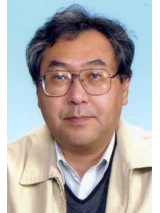
Yokoyama, Seiji
| Affiliation | Department of Mechanical Engineering |
|---|---|
| Title | Associate Professor |
| Fields of Research | Physical chemistry of metals / Recycle |
| Degree | Doctor of engineering |
| Academic Societies | Iron and Steel Institute of Japan / Ceramic Society of Japan |
| yokoyama@me Please append ".tut.ac.jp" to the end of the address above. |
|
| Laboratory website URL | http://www.tf.me.tut.ac.jp/ |
| Researcher information URL(researchmap) | Researcher information |
Research
Heretofore, I had mainly performed the study on the physical chemistry of the molten metal, such as the dissolution between molten slag and refractory brick, the enhancement of evaporation of molten metals in reactivity gas flows and the formation of ultra-fine particles of metallic compounds, and the formation of fine particles of alloys with the ammonia splashing method that was developed by me and so on.
Now, I have studied the environmental issues, such as absorption and fixation of the carbon dioxide into wasted materials that contain calcium oxide, safety of the waste slag and recovery of the valuables form them. In addition, as the work of the recycling of the car, I have developed the dismantling tools and the separation machine of copper from wire harness, and synthesized the activated carbon from the covering plastic materials.
Theme1:Absorption and fixation of carbon dioxide into wasted material that contains calcium oxide
Overview
Increase in concentration of carbon dioxide in air, which is one of the greenhouse gases, causes the global warming. The study and development on the separation, absorption and fixation of carbon dioxide have been performed. On the other hand, slag is constantly discharged from the steel industries, and a large quantity of concrete (cement) will be wasted in future. Those materials contain calcium oxide which is easily reacted carbon dioxide. Therefore, I develop the technology to fix carbon dioxide in them.
The quantity of absorption of carbon dioxide in steel making slag under wet grinding is larger than that under dry grinding. The quantity of absorption and fixation of carbon dioxide is larger than the quantity of carbon dioxide which is exhausted from the reactor under operation. (Figure 1).
1) M.N.N.Hisyamudin(博士課程), S.Yokoyama and M.Umemoto:”Storage of CO2 in Low Al2O3 EAF Oxidizing Slag by Grinding with Vibration Mill”, Materials Science Forum, Vol.634-636 (2010), p.2927-2930
2) S.Yokoyama, R.Sato, N.H.B.M.Nor(博士課程), M.Umemoto: “Behavior of CO2 Absorption in Wet-grinding of Electronic Arc Furnace Reduction Slag by Vibration Ball Mill”, ISIJ International, Vol.50 (2010), No.3, p.482-489
Keywords
Theme2:Elution of slag in fresh and sea water
Overview
A large amount of slag is drained as a by-product from iron and steel industries. The development of is the new practical use technology of the slag demanded due to lack of the last disposal ground. As one of the usages, it is thought to use the slag as cover sand materials to ooze in waters. In this study, I perform an elution test of the slag to check the safety of the slag and to investigate the dissolution behavior of the slag into fresh and sea water. In addition, the slag contains valuable and harmful components. Separation and extraction of them from the slag have been studied.
1) S.Yokoyama, A.Suzuki, N.H.B.M.Nor(博士課程), H.Kanematsu, A.Ogawa, T.Takahashi, M.Izaki and M.Umemoto: “Serial Batch Elution of Electronic Arc Furnace Oxidizing Slag Discharged from Normal Steelmaking Process into Fresh Water”, ISIJ International, Vol.50 (2010), No.4, p.630-638
2) S.Yokoyama,A.Suzuki,M.Izaki,M.Umemoto:“Elution behavior of Electric Arc Furnace Slag in Fresh Water”,Tetsu-to-Hagane,Vol.95 (2009), No.5, p.434-443
Keywords
Theme3:Recycling of end of life vehicle
Overview
About 5,000,000 cars a year become the end of life vehicles now in Japan. As recycling of them, I perform the development of the dismantling tool for removal of the windshields from a car (Figure 3). In addition, I develop the new process using a rolling machine or mixer to separate copper wire mechanically from a wire harness that is used in a car. I investigate the effect of temperature, length and etc. of the wire harness on the recovery ratio.
1) S. Yokoyama, S. Takeuchi, M.N.N.Hisyamudin(博士課程):“Mechanical Separation of Metallic Copper from Polymer-Insulated Copper Wire”, International Conference on Advanced Materials and Processing Technology (AMPT2010), Paris, (France), 24?27 October 2010,AIP Conference Proceedings Vol. 1315, p.1527-1532
2) S. Yokoyama, S. Takeuchi, H. Hashimoto, S. Maki: “Mechanical Separation of Metallic Copper from PVC(polyvinylchloride) Coated Copper Wire of Wire Harness by Rolling”, Proceedings of the International Federation of Automotive Engineering Societies (FISITA-2006), Yokohama, (CD ROM)
Keywords
Title of class
Physics Laboratory(GEN_PRN11020)/ Seminar in Mechanical Engineering(MEC_BAC48010)/ Supervised Research(MEC_BAC48010)/ Physical Chemistry of Materials(MEC_BAC31320)/ Materials Analysis(MEC_BAC34022)/ Seminar in Mechanical Engineering 1(MEC_MAS51010)/ Seminar in Mechanical Engineering 2(MEC_MAS61010)/ Supervised Research in Mechanical Engineering(MEC_MAS61010)/ Advanced Chemical processing of Materials(MEC_BAC31320)/ Supervised Seminar in Mechanical Engineering 1(MEC_DOC71010)/ Supervised Seminar in Mechanical Engineering 2(MEC_DOC71010)/ Advanced Manufacturing Processings(MEC_DOC74020)

